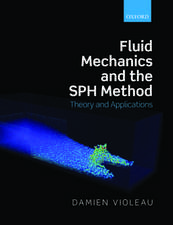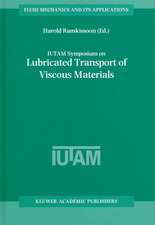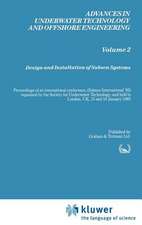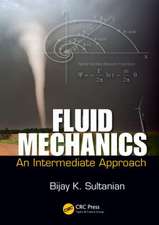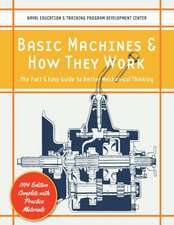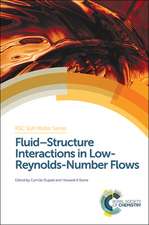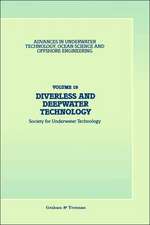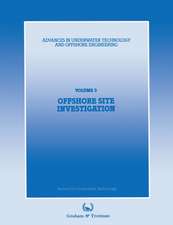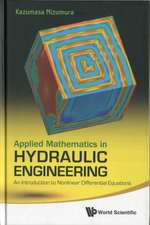SUBTECH ’91: Back to the Future. Papers presented at a conference organized by the Society for Underwater Technology and held in Aberdeen, UK, November 12–14, 1991: Advances in Underwater Technology, Ocean Science and Offshore Engineering, cartea 27
Editat de Society for Underwater Technology (SUT)en Limba Engleză Paperback – 23 aug 2014
Din seria Advances in Underwater Technology, Ocean Science and Offshore Engineering
- 24%
 Preț: 792.71 lei
Preț: 792.71 lei -
 Preț: 380.84 lei
Preț: 380.84 lei - 15%
 Preț: 641.03 lei
Preț: 641.03 lei - 18%
 Preț: 948.92 lei
Preț: 948.92 lei - 18%
 Preț: 1226.73 lei
Preț: 1226.73 lei - 18%
 Preț: 947.98 lei
Preț: 947.98 lei - 15%
 Preț: 642.18 lei
Preț: 642.18 lei - 18%
 Preț: 1224.18 lei
Preț: 1224.18 lei -
 Preț: 397.16 lei
Preț: 397.16 lei - 15%
 Preț: 639.25 lei
Preț: 639.25 lei - 18%
 Preț: 1225.31 lei
Preț: 1225.31 lei - 18%
 Preț: 944.19 lei
Preț: 944.19 lei - 18%
 Preț: 1548.44 lei
Preț: 1548.44 lei - 15%
 Preț: 640.37 lei
Preț: 640.37 lei - 18%
 Preț: 949.73 lei
Preț: 949.73 lei - 18%
 Preț: 1223.43 lei
Preț: 1223.43 lei - 15%
 Preț: 645.14 lei
Preț: 645.14 lei - 15%
 Preț: 642.83 lei
Preț: 642.83 lei - 18%
 Preț: 957.62 lei
Preț: 957.62 lei - 18%
 Preț: 1260.20 lei
Preț: 1260.20 lei - 18%
 Preț: 954.45 lei
Preț: 954.45 lei -
 Preț: 394.71 lei
Preț: 394.71 lei - 15%
 Preț: 635.01 lei
Preț: 635.01 lei - 15%
 Preț: 697.47 lei
Preț: 697.47 lei - 18%
 Preț: 1223.25 lei
Preț: 1223.25 lei - 15%
 Preț: 638.57 lei
Preț: 638.57 lei - 18%
 Preț: 949.73 lei
Preț: 949.73 lei - 18%
 Preț: 1239.99 lei
Preț: 1239.99 lei - 15%
 Preț: 642.03 lei
Preț: 642.03 lei - 18%
 Preț: 1223.74 lei
Preț: 1223.74 lei
Preț: 392.21 lei
Nou
Puncte Express: 588
Preț estimativ în valută:
75.05€ • 78.57$ • 62.10£
75.05€ • 78.57$ • 62.10£
Carte tipărită la comandă
Livrare economică 05-19 aprilie
Preluare comenzi: 021 569.72.76
Specificații
ISBN-13: 9789401055697
ISBN-10: 9401055696
Pagini: 368
Ilustrații: X, 354 p. 55 illus.
Dimensiuni: 155 x 235 x 19 mm
Greutate: 0.51 kg
Ediția:Softcover reprint of the original 1st ed. 1991
Editura: SPRINGER NETHERLANDS
Colecția Springer
Seria Advances in Underwater Technology, Ocean Science and Offshore Engineering
Locul publicării:Dordrecht, Netherlands
ISBN-10: 9401055696
Pagini: 368
Ilustrații: X, 354 p. 55 illus.
Dimensiuni: 155 x 235 x 19 mm
Greutate: 0.51 kg
Ediția:Softcover reprint of the original 1st ed. 1991
Editura: SPRINGER NETHERLANDS
Colecția Springer
Seria Advances in Underwater Technology, Ocean Science and Offshore Engineering
Locul publicării:Dordrecht, Netherlands
Public țintă
ResearchCuprins
1. Back to the Future.- Production Technology for Subsea Development wells.- Flexible Pipe Technology — A Decade of Change.- A Review of Past and Future Developments in Bundled Pipeline Installation by the Mid Depth Tow Method (Abstract).- Subsea Repair of Concrete Weight Coating on 30? North Sea Pipeline (Abstract).- Developing the Troll Project.- Wellhead Protection at Gannet B (Abstract).- Installation and Maintenance of Subsea Isolation Valves.- Review of Subsea Isolation Valves Installations in the UK North Sea.- Recent Developments in the Design of Subsea Isolation Valve Installations.- 2. Subsea Field Developments.- Dynamically Positioned Vessels — Their Suitability and Safe Operations.- Getting the DP Act Together.- Subsea Support Vessel for the Nineties.- Diving and Underwater Services — An Overview.- Advances in ROV Tooling for Subsea Cable Repair and Maintenance.- The Application of Work Class ROV’s — An overview.- R.O.V. Personnel Training Past, Present and Future.- 3. Equipment Development.- The FUDT-Project (Research and Development Project in Diving Technology).- Hyperbaric Pipeline Welding Beyond 600msw: A Conceptual Proposal.- ROV Operated Electrical Connector.- 4. Safety.- Hyperbaric Evacuation.- Risk Assessment of a Hyperbaric Evacuation System.- Diving Incident Data — The Way Ahead.- An End to Decompression Sickness? A New Approach to the Decompression Disorders.- A New Approach to Air Diving.- HADES, Highest Accumulated Decompression Score.- Inshore Diver Safety — A Review of Recent Developments.- 5. Tomorrow’s World.- Optimisation of Underwater Inspection Programmes.- Real Time Photogrammetry — A Technique for Today or Tomorrow?.- Alternative Approaches to Pipeline Survey: The Pipeline Engineer’s View.- Pipeline FreespanMonitoring.

